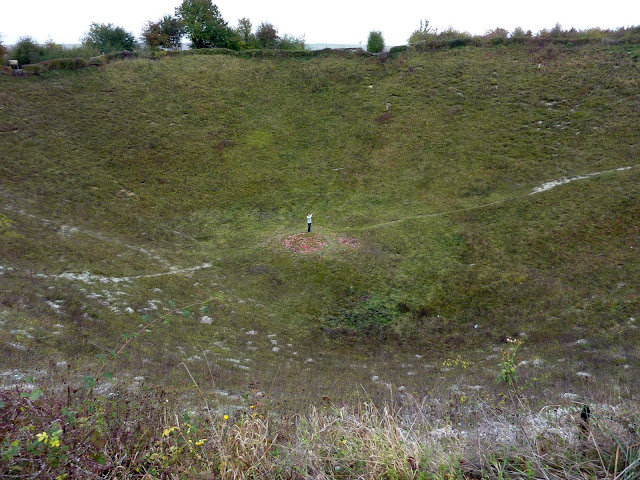I dunno if 25m of earth would offer more protection than 30m of water, i presume a Schwerer Gustaf shell would plow trough both as if it was butter. In fact afaik water is far harder to compress than earth and would distrbute its upward pressure better therefore actually likely offers more resistance especially the deeper the projectile goes. But if i read correctly that ammunition magazine also had 10 meters of concrete protection. I guess the 10 meters was also there to resist the pressure of the water. Also i read somewhere else that a Schwerer gustav shell would detonate 30m underground on average anyway, not unsurprising for a shell of that size and velocity i guess. Not to hard to see when looking at the kind of craters it left behind neither:
fig 1a: Germans and their rediculous guns omfg
Wiki gives an overview of it's performance around Sevastopol:
The siege of Sevastopol was the gun's first combat test. 4,000 men and five weeks were needed to get the gun in firing position; 500 men were needed to fire it.[7] Installation began in early May, and by the 5th of June the gun was ready to fire.[8] The following targets were engaged:
- 5 June
- Coastal guns at a range of 25,000 m. Eight shells fired.
- Fort Stalin. Six shells fired.
- 6 June
- Fort Molotov. Seven shells fired.
- "White Cliff" also known as "Ammunition Mountain": an undersea ammunition magazine in Severnaya ("Northern") Bay. The magazine was sited 30 metres under the sea with at least 10 metres of concrete protection. After nine shells were fired, the magazine was ruined and one of the boats in the bay sunk.[9]
- 7 June
- Firing in support of an infantry attack on Südwestspitze, an outlying fortification. Seven shells fired.
- 11 June
- Fort Siberia knocked out of action. Five shells fired.
- 17 June
- Maxim Gorky Fortresses bombarded. Maxim Gorky 1 knocked out of action, Maxim Gorky 2 damaged. Five shells fired.
Ultimatly Schwerer Gustav was designed to deal with the Maginot, i believe the Germans just went to specifications that would "surely make it effective". You would think that it would be a pretty stupid effort to design and build such a gun if it would also prove to be ineffective besides the stupendous amount of prepperation and resources needed to even put it to bear.



